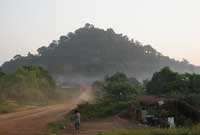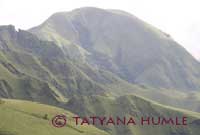HOME » Other sites
Other sites
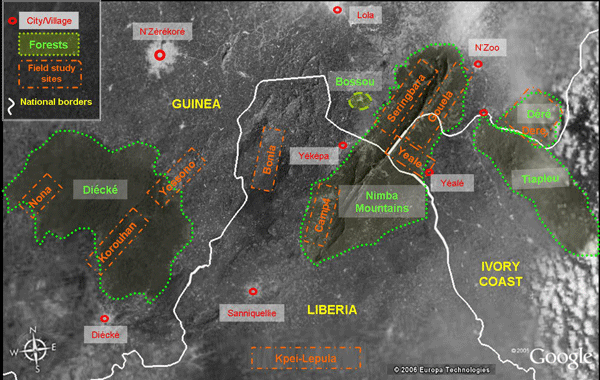
Schematic map of the different field research sites in the region
Guinea

Côte d'Ivoire
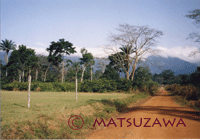
The village of Yealé (7° 32' N and 8° 25' W) is located 12 km, southeast of Bossou, on the other side of the Nimba Mountains in Côte d'Ivoire. Matsuzawa and Yamakoshi established this study site in 1993. Since 1993, a plan of habituation of the chimpanzees in that area has been in progress, in collaboration with a local agent of the "Centre des Eaux et Forets" of Danane. Preliminary surveys, carried out in the region, and information from local people reveal that maybe three groups of chimpanzees reside in the area, each one adjacent to one of three major rivers found in the Reserve: the Nuon, the Yan and the Toua. Humle has been continuing more intensive research at this site since 1999. A main campsite has been established within the reserve (Yanleu Camp: 7° 33' N and 8° 28' W), three and half hours walk from the village. Since 2001, due to political unrest in the region, no one from the KUPRI International team has unfortunately been able to resume research at this site.
Guinea
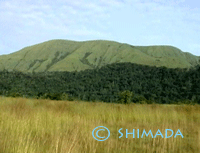
The N'Zo-Gouéla site (7° 37'N and 8°22'W) is located 15km southeast of Bossou (sub-prefecture of N'Zo), on the North East side of the Nimba Mountains, an goes across the border with Côte d'Ivoire in the south slope of the mountain relief. This site is very interesting because it contains chimpanzees and presents a real homogeneity in terms of ecology. The most recent survey carried out reports a relatively preserved primary forest from the bottom edge of the foothills till the altitude steppes near to the summits. Daily observations of many chimpanzee tracks have confirmed the species is still present in this side of the Nimba Mountains Biosphere Reserve although the presence of numerous traps, cartridges and hunters encountered in the core area of the reserve clearly demonstrates poaching is being practiced.
GUINEA
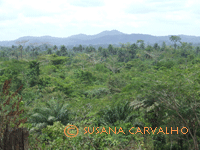
The forest of Diécké is located about 50 km to the west of Bossou. It is a reserve extending over 700 sq. km in area, stretching about 35 km from north to south and 35 km from east to west. There are two main rivers (3 major watercourses) that cross the forest: Nyé River (running to the South, on the West side and Gbin River (divided in Gbin and Gbin-bé) running to the South on the East side. All the forest is replete of secondary waterlines often creating swamping areas. According to local guides, crossing main rivers during rain season can be very hard, sometimes making impossible to reach the heart of the forest. In this part of the country, dry season is very short, normally lasting from December/January to March. Geologically, Diécké is part of the West African craton with Precambric rocks, essentially igneous and metamorphic (Clark, 1967). The forest is under the control of the "Centre Forestier" de N'Zérékoré. The study sites, which we have surveyed thus far, are located beside two villages: Yossono (west of the reserve (7° 38' N and 8° 30' W)) and Nonah (east of the reserve (7° 33' N and 9° 05' W)). The explored sites consist primarily of primary forest covering small hills, of which the highest peak is at 589 m above sea level (Matsuzawa et al., 1999). It still remains undetermined as to how many chimpanzees inhabit this reserve and how many communities pervade in the area. But some preliminary behavioral data have emerged, especially concerning tool-use at those sites (cf. Humle and Matsuzawa, 2001). There were recent reports of hunting of chimpanzees in the Yossono area dating back to July 2001, while hunting pressure at Nonah does not appear to be as high. But hunting seems to be a huge problem within this reserve and may pose a considerable threat to the chimpanzee populations living in that region.
Guinea
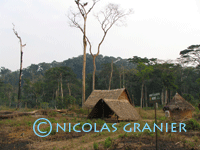
The Déré forest in Guinea, contiguous with the Tiapleu classified Forest in Côte d'Ivoire, is covering an 8920 hectares surface and lies 15 kilometres away from the base of Monts Nimba. Stretched between 7°32'50'' and 7°38' latitude N, and 8°10'50'' and 8°18'50'' longitude W, it is one of the most easterly points of the forest zone in Guinea. With a very irregular topography, this forest contains swamps, lowlands and hills culminating at Mont Tiéton (742 meters). Comparable to Mont Nimba forests, the Déré forest contains vegetal species of high value. Large mammals can be encountered, and the presence of the pygmy hipopotamus has been reported in 2001 (Pascual). In the early 1990s, it was still called the black forest ("la forêt noire"), because of its closing canopy, its fauna and floristic richness, its important hydrographical net including springs of several watercourses and the ritual activities local people were conducting inside. Sadly, this situation has drastically changed. Human encroachment on the Déré forest is very high. People have colonized the whole area for cultivation leaving a very fragmented forest.
Liberia
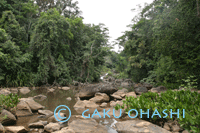
Bossou is located only a few kilometers from the Liberian border, and Bossou chimpanzees are known to occasionally cross the border into the Liberian forest (Ohashi 2006). On February 2006, Ohashi started to conduct surveys in Nimba county in Liberia to clarify the distribution of chimpanzees there, and found that chimpanzees are present in at least three areas (Bonla, Camp4, and Kpei-Lepula). Based on indirect evidence, chimpanzees were confirmed to use tools to dip for ants (Bonla area), and to crack open Coula nuts (Bonla and Kpei-Lepula).



